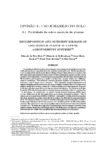Please use this identifier to cite or link to this item:
http://www.alice.cnptia.embrapa.br/alice/handle/doc/904191| Title: | Decomposition and nutrient release of leguminous plants in coffee agroforestry systems. |
| Authors: | MATOS, E. da S.  MENDONÇA, E. de S.   CARDOSO, I. M.   LIMA, P. C. de   FREESE, D.   |
| Affiliation: | EDUARDO DA SILVA MATOS, CPAMT; EDUARDO DE SÁ MENDONÇA, UFES; IRENE MARIA CARDOSO, UFV; PAULO CÉSAR DE LIMA, EPAMIG; DIRK FREESE, Brandenburg University of Technology. |
| Date Issued: | 2011 |
| Citation: | Revista Brasileira de Ciência do Solo, Campinas, v. 35, p. 141-149, 2011. |
| Description: | Abstract: Leguminous plants used as green manure are an important nutrient source for coffee plantations, especially for soils with low nutrient levels. Field experiments were conducted in the Zona da Mata of Minas Gerais State, Brazil to evaluate the decomposition and nutrient release rates of four leguminous species used as green manures (Arachis pintoi, Calopogonium mucunoides, Stizolobium aterrimum and Stylosanthes guianensis) in a coffee agroforestry system under two different climate conditions. The initial N contents in plant residues varied from 25.7 to 37.0 g kg-1 and P from 2.4 to 3.0 g kg-1. The lignin/N, lignin/polyphenol and (lignin+polyphenol)/N ratios were low in all residues studied. Mass loss rates were highest in the first 15 days, when 25 % of the residues were decomposed. From 15 to 30 days, the decomposition rate decreased on both farms. On the farm in Pedra Dourada (PD), the decomposition constant k increased in the order C. mucunoides < S. aterrimum < S. guianensis < A. pintoi. On the farm in Araponga (ARA), there was no difference in the decomposition rate among leguminous plants. The N release rates varied from 0.0036 to 0.0096 d-1. Around 32 % of the total N content in the plant material was released in the first 15 days. In ARA, the N concentration in the S. aterrimum residues was always significantly higher than in the other residues. At the end of 360 days, the N released was 78 % in ARA and 89 % in PD of the initial content. Phosphorus was the most rapidly released nutrient (k values from 0.0165 to 0.0394 d-1). Residue decomposition and nutrient release did not correlate with initial residue chemistry and biochemistry, but differences in climatic conditions between the two study sites modified the decomposition rate constants. |
| Thesagro: | Leguminosa Nutriente Decomposição Agrossilvicultura Cafeicultura Leguminosae |
| NAL Thesaurus: | Biogeochemical cycles Agroforestry Plant residues Fabaceae |
| Keywords: | Agrofloresta Ciclagem de nutrientes |
| Type of Material: | Artigo de periódico |
| Access: | openAccess |
| Appears in Collections: | Artigo em periódico indexado (CPAMT)  |
Files in This Item:
| File | Description | Size | Format | |
|---|---|---|---|---|
| 2011AP08.pdf | 750.86 kB | Adobe PDF |  View/Open |









